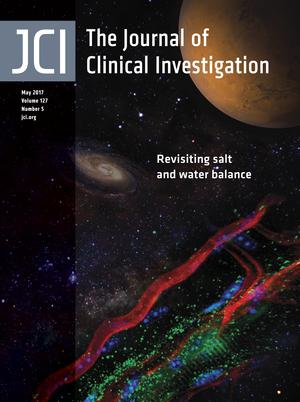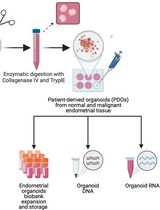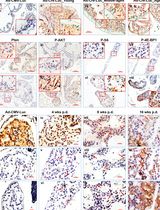- EN - English
- CN - 中文
In vivo Leukemogenesis Model Using Retrovirus Transduction
采用逆转录病毒转导的体内白血病生成模型
发布: 2017年12月05日第7卷第23期 DOI: 10.21769/BioProtoc.2627 浏览次数: 9246
Abstract
Various genetic alterations such as chromosomal translocation cause leukemia. For examples, gene rearrangements of the mixed-lineage leukemia (MLL) gene generate MLL fusion genes, whose products are potent oncogenic drivers in acute leukemia. To better understand the mechanism of disease onset, several murine leukemia models using retroviral gene transduction, xenograft, or Cre-mediated chromosomal translocation have been developed over the past twenty years. Particularly, a retroviral gene transduction-mediated murine leukemia model has been frequently used in the leukemia research field. Here, we describe the detailed protocol for this model.
Keywords: Mixed lineage leukemia (混合细胞系白血病)Background
Gene rearrangements generate mixed-lineage leukemia (MLL) fusion genes, which cause highly aggressive acute leukemia. MLL-rearrangements are often associated with few additional genetic alterations and poor clinical outcomes (Andersson et al., 2015). Wild-type MLL enhances and maintains the expression of a subset of genes, including homeobox (Hox) genes, to stimulate the expansion of immature progenitors (Jude et al., 2007). The expression of Hoxa9 and Meis1 is highest in the immature progenitor/stem cell fraction, but gradually declines as cells differentiate, and eventually diminishes in terminally-differentiated cell fractions (Somervaille and Cleary, 2006; Yokoyama et al., 2013). The MLL fusion protein constitutively up-regulates the expression of target genes, including Hoxa9 and Meis1, to immortalize immature progenitor cells and cause leukemia in vivo (Ayton and Cleary, 2003; Lavau et al., 1997). To date, more than 130 different MLL-rearrangements have been identified (Meyer et al., 2017). Two-thirds of MLL-rearranged leukemia cases are caused by fusion with a gene that is part of the AF4 family-ENL family-P-TEFb (AEP) complex (Yokoyama et al., 2010). The MLL fusion proteins constitutively form an MLL/AEP hybrid complex on the target chromatin (Okuda et al., 2014; Yokoyama et al., 2010), which further associates with the SL1 complex to activate RNA polymerase II-dependent transcription (Okuda et al., 2015 and 2016). AEP-mediated transactivation of MLL target genes transformed myeloid progenitors ex vivo, but did not cause leukemia in vivo, which suggested that other function is additionally required for in vivo leukemogenesis (Okuda et al., 2017). Recently, we showed that the ability to recruit the DOT1L complex is necessary to cause leukemia in vivo in addition to the ability to recruit AEP using in vivo leukemogenesis model. Thus, the combinatorial use of the in vivo leukemogenesis model and myeloid progenitor transformation assay is necessary to dissect the functional properties of oncogenes. In this protocol, we describe the in vivo leukemogenesis model using retroviral transduction in detail.
Materials and Reagents
- Pipette tips
- Tissue culture 10-cm dish (Greiner Bio One International, catalog number: 664160 )
- Collagen-coated tissue culture 10-cm dishes (Corning, catalog number: 354450 )
- 15-ml conical centrifuge tubes (Thermo Fisher Scientific, Thermo ScientificTM, catalog number: 339650 )
- Terumo syringe® 10-ml (Terumo, catalog number: SS-10ESZ )
- Terumo needle 21 G x1 ½” (Terumo, catalog number: NN-2138S )
- MS column (Miltenyi Biotec, catalog number: 130-042-201 )
- Pre-separation filter (Miltenyi Biotec, catalog number: 130-041-407 )
- Tissue culture 48-well plate (Thermo Fisher Scientific, Thermo ScientificTM, catalog number: 150687 )
- Millex-GV 0.45-µm PVDF 33 mm sterile syringe filter (Merck, catalog number: SLHV033RB )
- Terumo® tuberculin syringe 26 G x ½” (Terumo, catalog number: SS-01T2613S )
- Terumo Myjector® insulin syringe 29 G x ½” (Terumo, catalog number: SS-05M2913 )
- Terumo syringe® 1-ml (Terumo, catalog number: SS-01T )
- Terumo needle 18 G x1 ½” (Terumo, catalog number: NN-1838S )
- Tissue culture 12-well plates (Thermo Fisher Scientific, Thermo ScientificTM, catalog number: 150628 )
- Bottle-top filter 0.2-µm PVDF (Corning, catalog number: 431098 )
- Five-week-old female C57BL/6JJcl mice (donor mice) (CLEA Japan, Tokyo, Japan)
- Seven-week-old female C57BL/6JJcl mice (recipient mice) (CLEA Japan)
- Platinum-E packaging (PLAT-E) cell line (Morita et al., 2000) (gifted from Dr. Toshio Kitamura, or Cell Biolabs, catalog number: RV-101 )
- WEHI-3 (ATCC, catalog number: TIB-68 )
- pMSCV-neo vector (Takara Bio, ClontechTM, catalog number: 634401 )
- pMSCV-neo-MLL-ENL (request to Akihiko Yokoyama: ayokoyam@ncc-tmc.jp)
- Trypsin-EDTA solution (NACALAI TESQUE, catalog number: 32778-34 )
- LipofectamineTM 2000 transfection reagent (Thermo Fisher Scientific, InvitrogenTM, catalog number: 11668019 )
- Opti-MEMTM I medium (Thermo Fisher Scientific, InvitrogenTM, catalog number: 31985070 )
- 70 % ethanol
- CD117 microbeads, mouse (Miltenyi Biotec, catalog number: 130-091-224 )
- 2.5% Baytril solution (Bayer, BaytrilTM, https://www.baytril.com/en/farm-animals/product/oral/)
- Polybrene infection/transfection Reagent (10 mg/ml) (Merck, catalog number: TR-1003-G )
- Bambanker serum-free freezing media (NIPPON Genetics, catalog number: BB01 )
- G418 solution (NACALAI TESQUE, catalog number: 16513-84 )
- Sodium chloride (NaCl) (NACALAI TESQUE, catalog number: 31320-05 )
- Na2HPO4·12H2O (Wako Pure Chemical Industries, catalog number: 196-02835 )
- Potassium dihydrogenphosphate (KH2PO4) (Wako Pure Chemical Industries, catalog number: 164-22635 )
- Potassium chloride (KCl) (Wako Pure Chemical Industries, catalog number: 160-22115 )
- Fetal bovine serum (FBS) (NICHIREI, Sigma-Aldrich, catalog number: 172012-500ml )
- Penicillin-streptomycin-glutamine (P/S) solution (NACALAI TESQUE, catalog number: 06168-34 )
- Dulbecco’s modified Eagle medium (DMEM) (NACALAI TESQUE, catalog number: 08459-64 )
- RPMI 1640 (NACALAI TESQUE, catalog number: 30264-56 )
- Ethylenediaminetetraacetic acid (EDTA) (NACALAI TESQUE, catalog number: 15130-95 )
- Sodium hydroxide (NaOH) (Wako Pure Chemical Industries, catalog number: 198-13765 )
- Ammonium chloride (NH4Cl) (Wako Pure Chemical Industries, catalog number: 017-02995 )
- Potassium hydrogen carbonate (KHCO3) (Wako Pure Chemical Industries, catalog number: 166-03275 )
- Bovine serum albumin (BSA) (Wako Pure Chemical Industries, catalog number: 019-23293 )
- Murine stem cell factor (SCF) (PeproTech, catalog number: 250-03 )
- Murine interleukin-3 (IL-3) (PeproTech, catalog number: 213-13 )
- Murine interleukin-6 (IL-6) (PeproTech, catalog number: 216-16 )
- Murine granulocyte-macrophage colony-stimulating factor (GM-CSF) (PeproTech, catalog number: 315-03 )
- IMDM powder (Thermo Fisher Scientific, GibcoTM, catalog number: 12200036 )
- Sodium hydrogen carbonate (NaHCO3) (Wako Pure Chemical Industries, catalog number: 195-14515 )
- Methyl cellulose (viscosity: 4,000 cP) (Sigma-Aldrich, catalog number: M0512 )
- Beta-mercaptoethanol (NACALAI TESQUE, catalog number: 21418-84 )
- Sodium pentobarbital (NACALAI TESQUE, catalog number: 02095-04 )
- 25x phosphate-buffered saline Ca2+/Mg2+-free (PBS) (see Recipes)
- D10 media (see Recipes)
- R10 media (see Recipes)
- R10W10 media (see Recipes)
- 0.5 M EDTA solution (see Recipes)
- ACK lysis buffer (see Recipes)
- SM buffer (see Recipes)
- Cytokine stocks (see Recipes)
- AC media (see Recipes)
- Anesthetic solution (see Recipes)
Equipment
- Pipetman P2, P20, P200, P1000
- 5% CO2 incubator 37 °C
- 5% CO2 incubator 32 °C
- Centrifuge for 15-ml conical tubes
- Cell counter (Hemacytometer)
- Laminar flow cabinet
- Surgical scissors and forceps
- MACS multistand (Miltenyi Biotec, catalog number: 130-042-303 )
- MiniMACS separator (Miltenyi Biotec, catalog number: 130-042-102 )
- Portable Pipet-Aid® XP pipette controller (Drummond Scientific, catalog number: 4-000-101 )
- -80 °C freezer
- 1-L glass bottle
- Autoclave
- Shaker
- Gammacell® 40 exactor with cesium-137 (Best Theratronics, model: Gammacell® 40 )
- Inverted microscope for general cell culture
Software
- GraphPad Prism (GraphPad Software, La Jolla, CA, USA)
Procedure
文章信息
版权信息
© 2017 The Authors; exclusive licensee Bio-protocol LLC.
如何引用
Okuda, H. and Yokoyama, A. (2017). In vivo Leukemogenesis Model Using Retrovirus Transduction. Bio-protocol 7(23): e2627. DOI: 10.21769/BioProtoc.2627.
分类
癌症生物学 > 通用技术 > 动物模型
细胞生物学 > 细胞分离和培养 > 转化
癌症生物学 > 瘤形成 > 白血病生成
您对这篇实验方法有问题吗?
在此处发布您的问题,我们将邀请本文作者来回答。同时,我们会将您的问题发布到Bio-protocol Exchange,以便寻求社区成员的帮助。
提问指南
+ 问题描述
写下详细的问题描述,包括所有有助于他人回答您问题的信息(例如实验过程、条件和相关图像等)。
Share
Bluesky
X
Copy link











